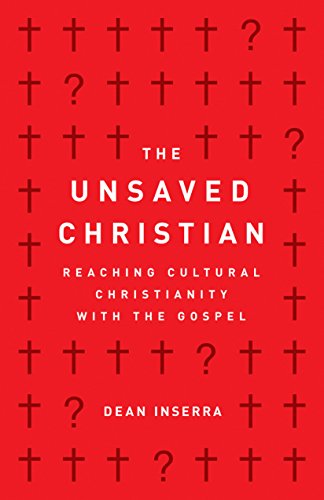
by Dean Inserra
The Unsaved Christian: Reaching Cultural Christianity with the Gospel. Chicago: Moody Publishers, 2019. 207 pp. $11.99.
This review was originally published in Themelios April, 2021.
“Do you want to go to heaven when you die?” Most people who believe that heaven is a real place want to go there when they die. It is certainly preferable to the alternative. Yet how many people have responded in the affirmative, offered a quick prayer, made a decision, and years later base their salvation on a distant experience? Dean Inserra, pastor of City Church in Tallahassee, Florida, has rendered a great service to the church in this book with an intentionally oxymoronic title. Although unsaved Christians do not really exist, it is apparent that many who identify with Christianity as a religion have never experienced the new birth through faith in Christ. The book reveals a pastor burdened to reach religious unbelievers and point them to Jesus. He has numerous friendships with unsaved people and engages in intentional evangelism. The book is replete with stories, anecdotes, and personal encounters from his own experience.
At the heart of the book is the predicament of cultural Christians who may know a great deal about Christ without knowing Christ. They are lost and are trusting something other than Christ for their salvation. These are neither scoffers nor antagonistic toward Christianity. They may lead moral lives, attend church regularly, and are falsely assured of their standing before God. Inserra describes cultural Christianity as a religion “practiced by more Americans than any other faith or religion” (p. 13) and as the “most underrated mission field in America” (p. 15). The challenge for Christians on mission is reaching people who are familiar with Christianity and Christian lingo yet appear immune or blind to their need of repentance and faith in a crucified and risen Savior. Among these unsaved Christians are those who are “religious, but not repentant” (p. 15).
The book begins with the difficulty many cultural Christians have in seeing themselves as lost and in need of a savior. The book ends with a call to action and an appeal for the readers to examine their own hearts and lives in case they are unknowingly cultural Christians. The book’s fifteen chapters each examine a different emphasis or religious experience “to illustrate common ways people may place faith in a false gospel and still identify themselves as Christians” (p. 9). Each chapter begins with a pithy quote from past and present Christian leaders and ends with discussion questions. In chapter 9, Inserra contrasts making decisions with making disciples and does well in pointing out the danger of depending on the “sinner’s prayer” as the basis for one’s assurance of salvation. In that light, he might have avoided speaking about “commitment to Jesus Christ” (p. 18) and of barriers men and women face in “making decisions to become Christians” (p. 149).
Inserra leaves few areas of cultural Christianity untouched. He works his way geographically and demographically through the United States and will cause many a pastor and church member to see themselves in unvarnished depictions. His descriptions range from civic religion, “which promotes a god without any definition and a generic faith that demands and asks nothing of its followers” (p. 36), to the Bible Belt of faith, family, and football, where “being seen as a Christian can be more important than actually being a Christian” (p. 172). Along the way, he turns his attention to nominal, generational Catholics with whom he finds gospel conversations “far easier than with nominal Protestants” (p. 146). He critiques mainline Protestantism whose brand of Christianity is “a completely different religion posing as the Christian faith” (p. 159). His own conversion came about after years in a mainline Protestant church, where he confesses that he had never truly heard the gospel. He examines models of church membership which have the feel of a country club “with low or no expectations” (p. 76) and advocates a regenerate, baptized church membership. In addition, and this might raise eyebrows, prospective members in his church must agree to join a Bible study or involvement in one of the church’s “growth environments” (p. 81).
Unsaved Christians engages the reader with real-life situations the author has faced. Inserra offers salutary suggestions for starting points in building bridges for the gospel. Many of the descriptions, illustrations and issues are limited in application due to different contexts of life and ministry. Almost everyone, however, will find one or more chapters that describe their faith community. The book is written for a wide audience and at a popular level. Most Christians will find it an easy and enjoyable read. Pastors and church members alike will benefit from the insights, encouragements, and practical application. They may also leave with a greater burden for the unsaved.